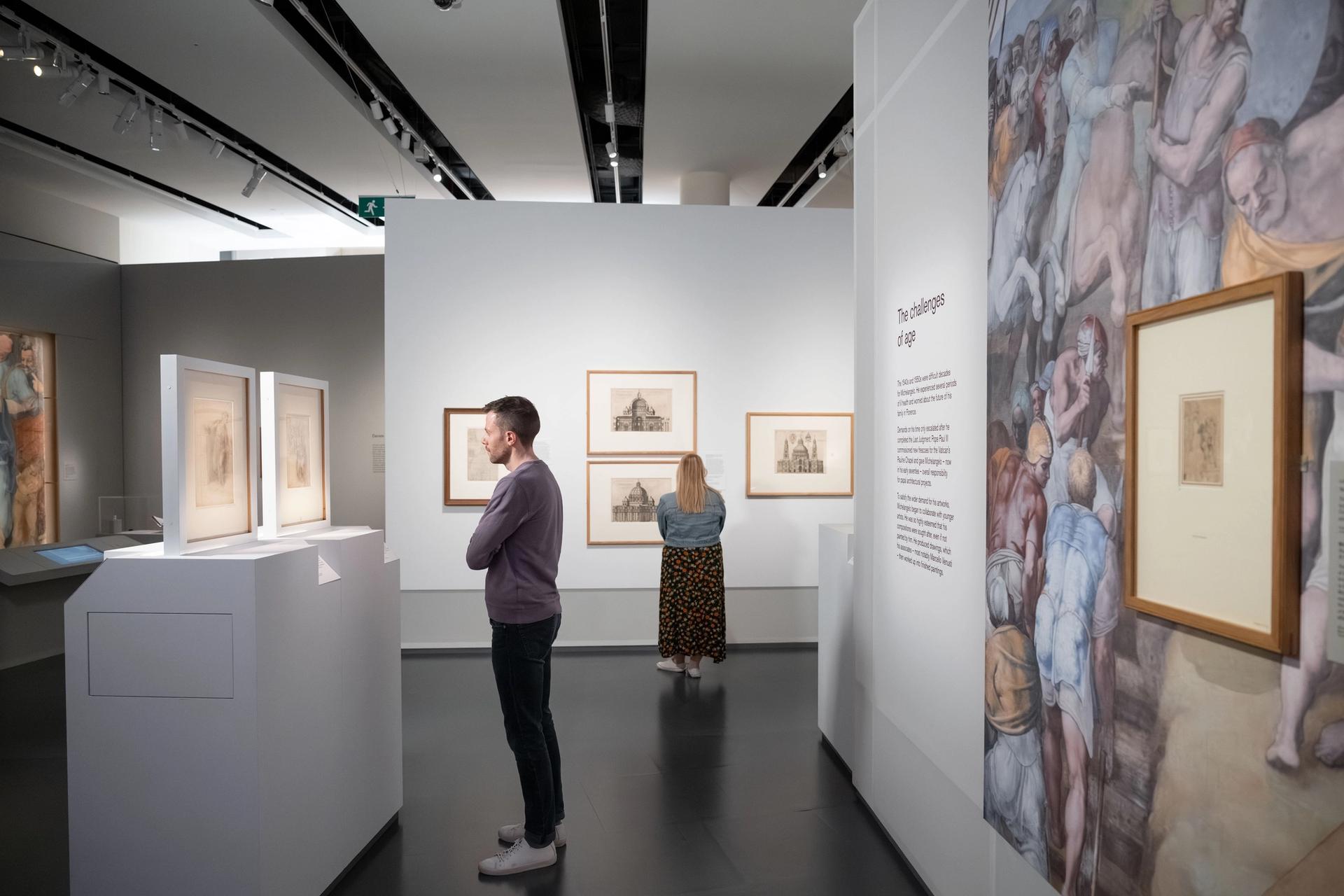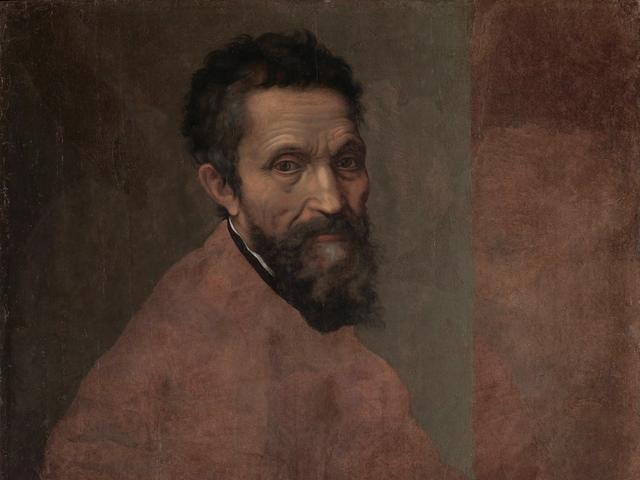Michelangelo (1475-1564) might be the most difficult Old Master to harness in exhibitions. Getting loans for the greats is always difficult, of course. But while Michelangelo’s body of work shares the same issues—scarcity, incompletion and polymathy—as Leonardo da Vinci’s, it also has another obstacle: scale. And this is doubly fiendish for a show about his later years.
The period marks Michelangelo’s definitive return to Rome in 1534 and his subsequent projects for successive popes, patrons and associates. His major works of the time—The Last Judgement in the Sistine Chapel (1534-41), the two frescoes for the less famous Pauline Chapel nearby (1542-50) and the dome of St Peter’s Basilica in Rome—are, plainly, immovable. He made few sculptures, and those, in particular the Florentine and Rondanini pietàs, are unlikely to be lent. So, the curators have given themselves a tricky conundrum: how do you reflect the extraordinary achievements of late Michelangelo?
The exhibition offers as much tantalisation as it does satisfaction
The answer is through smaller scale gems and rich context. The British Museum’s stellar collection of drawings forms the core of the show, supplemented by excellent loans from elsewhere. But the focus is also on social and political vicissitudes from the 1530s to the 1560s, and Michelangelo’s place within them.

A study for the Last Judgment by Michelangelo, made using black chalk on paper (1534–36) © The Trustees of the British Museum
The Eternal City was reeling from the Sack of Rome in 1527, when the troops of Charles V, the Holy Roman Emperor, caused carnage that stunned the papacy and sent shockwaves across Europe. The presence of Europe’s most famous artist was deemed necessary as the city sought to rebuild its fabric, its pride and reputation. Meanwhile, amid religious turbulence at the dawn of Protestantism, the birth of Italian reformist movements and the growing fervour of the Counter-Reformation, Michelangelo pondered his own faith.
His increasing focus on spiritual questions was an inevitable consequence of confronting his own mortality, which prompted practical decisions about his work, like his collaborations with painters, which the exhibition explores in depth. And with more than 500 letters to call on, the show and its catalogue leave us with a strong impression of the man himself: the most famous artist in Europe, widely admired, in demand and overworked, yet insecure. Few fireworks and showstoppers, then, but an abundance of drawings, letters, poems and books that builds an intimate portrait.
The exhibition is weakest where it aims for theatre. The audio quotes, in Italian and then English, might want to bathe the show in mystique and atmosphere but merely achieve a grating, affected croakiness. However, immediate irritation quickly gives way to wonder. We gain a wonderful sense of Michelangelo’s incomparable technical skills, whether in the briefest of sketches or in worked-up finished designs, but also of his use of drawing as a practice for thinking as well as making: compositions for one project cross-pollinate into others, eureka moments emerging from play.

Michelangelo's The Punishment of Tityus (1532) © His Majesty King Charles III 2024
One of his finest drawings is here: The Punishment of Tityus (1532) in black chalk from the Royal Collection. It illustrates the Ovidian myth of the lustful giant punished by being chained to a rock, where a vulture feasted on his liver for all eternity. The brilliance of Michelangelo’s treatment lies in its incomparable line, exquisite shading and tone in the more finished areas, the delicacy of the cross-hatching in looser sections, and in the dynamism of its iconography, where the vulture for Michelangelo becomes a magnificent eagle—surely one of the greatest ornithological drawings in art—and Tityus’s body is described with hot-blooded eroticism. Tommaso de’ Cavalieri, the young nobleman for whom the drawing was made, and for whom Michelangelo may have been expressing covert desire, wrote to the artist that he would study the Tityus and another drawing for two hours each day. And no wonder.
On the verso of the Tityus, Michelangelo ingeniously used the giant’s pose, turned 90°, as a study for the risen Christ, a theme that obsessed him and eventually led to the figure of Jesus in The Last Judgement. Several more drawings for the Sistine fresco are included, showing Michelangelo experimenting with conjuring the energy of clusters of bodies, and working out the precise poses of saints and sinners. A film accompanying the drawings shows the fresco in detail and maps the sketches onto precise figures in the final painting. It is a pity that the same cannot be done for the two frescoes in the Vatican’s Pauline Chapel, Michelangelo’s final paintings, which get short shrift here. Quite simply, barely any studies survive; the few that are here are mouthwatering.
Were there more, they would illustrate the increased fervency in Michelangelo’s religious beliefs, which are explored mostly through his friendship with Vittoria Colonna, the poet and noblewoman, in whose verse’s religious ardour he found a parallel. Colonna was part of a circle of evangelicals gathered around the English cardinal Reginald Pole, called the spirituali, whose beliefs echoed some of the reformist views of Lutheranism. Michelangelo and Colonna exchanged poems and letters but the chief result of their friendship was the gift to Colonna of two solemn yet spectacular drawings symbolic of their shared faith: the British Museum’s own Christ on the Cross (around 1555-64) and a pietà at the Isabella Stewart Gardner Museum in Boston (1540), sadly not in the show.
The drawings for Colonna led to various other works and objects, from engravings to paxes and paintings. The panels are not by Michelangelo himself, but collaborations in which his compositions were realised in paint by colleagues, most notably in the 1540s and 1550s with Marcello Venusti. The finest here is a crucifixion using Colonna’s Christ on the Cross alongside figures of the Virgin and St John that were drawn from marvellous separate Michelangelo drawings lent by the Musée du Louvre. Venusti’s paintings, of which there are several, offer fascinating insight into Michelangelo’s process and the means by which his imagery could be circulated, only enhancing his fame. But as objects they are somewhat disappointing; the master’s drawings are always stratospherically superior. One wishes Michelangelo had the time and energy to paint the panels himself.

Michelangelo's Christ on the Cross between the Virgin and St John (around 1555-64) © The Trustees of the British Museum
Perhaps the most extreme gulf of this kind relates to the museum’s cartoon, the Epifania (around 1550-53)—Michelangelo’s composition that is now, through conservation, partly released from the murk that has long reinforced its mystery. A fresco by the artist’s biographer Ascanio Condivi, who was a very limited painter, hangs alongside the cartoon. It is one of the many ways in which the exhibition offers as much tantalisation as it does satisfaction.
Still, there is much to stir and move us: examples of Michelangelo’s architectural drawings are testament to Gian Lorenzo Bernini’s estimation of his forebear’s divinity as an architect, while a final, chapel-like room with several late crucifixion drawings is perfectly pitched: a deeply moving meditation on faith and fragility. The solemn end to the show is only enhanced by the presence of his final letters to his nephew and heir in Florence, Leonardo Buonarroti.
The curators Sarah Vowles and Grant Lewis have made a good fist of tackling their impossible task. Of course, the best way to grapple with Michelangelo’s final 30 years (and much of his earlier life) is to visit Rome and the Vatican. In lieu of that, this show is a decent primer.

An installation view of Michelangelo: the Last Decades at the British Museum in London © The Trustees of the British Museum
What the other critics said
Among mixed reviews from British critics, The Telegraph’s Alastair Sooke notes that Michelangelo’s spiritual “ardour…may shock a secular audience” but praised the British Museum for not “shying away from Christian content”. For The Guardian’s Jonathan Jones, the omission of a more bodily ardour—Michelangelo’s sexual attraction to men—is symptomatic of how “so much fun is excluded”; he says he “found it hard work”. But Michelangelo’s spiritual reckoning moved Rachel Cooke, who says “it is the heart, as much as the eyes, that guides you through its eternal twilight”.
• Michelangelo: the Last Decades, British Museum, London, until 28 July
• Curators: Sarah Vowles and Grant Lewis.
• Tickets: £18 (concessions available)



